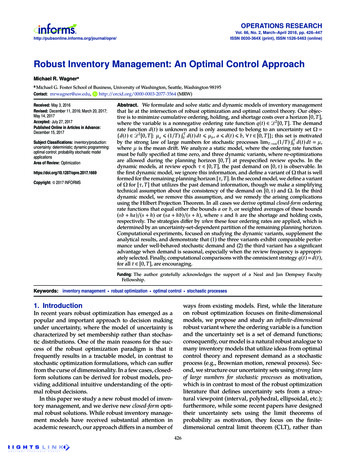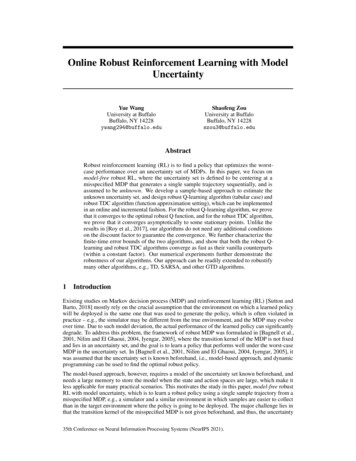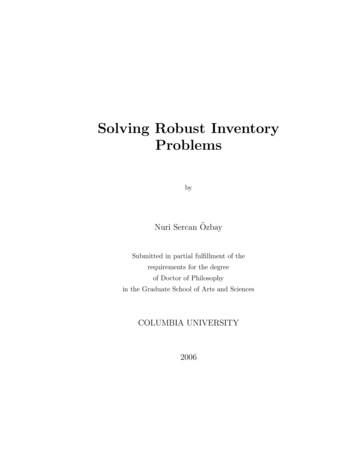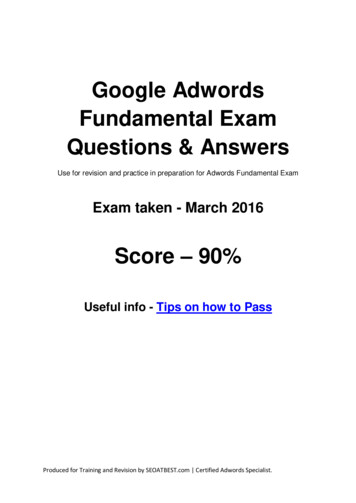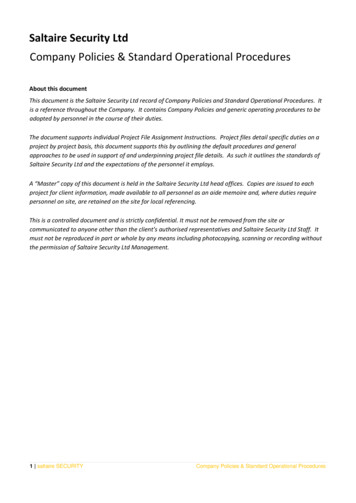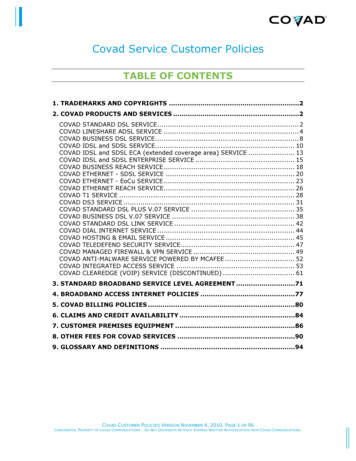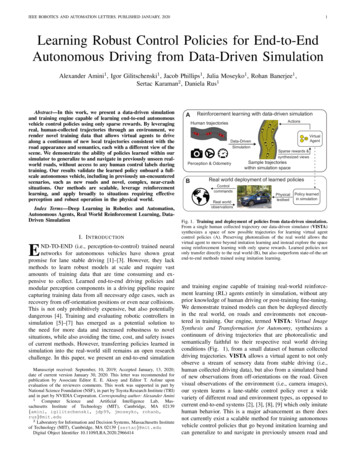
Transcription
IEEE ROBOTICS AND AUTOMATION LETTERS. PUBLISHED JANUARY, 20201Learning Robust Control Policies for End-to-EndAutonomous Driving from Data-Driven SimulationAlexander Amini1 , Igor Gilitschenski1 , Jacob Phillips1 , Julia Moseyko1 , Rohan Banerjee1 ,Sertac Karaman2 , Daniela Rus1Abstract—In this work, we present a data-driven simulationand training engine capable of learning end-to-end autonomousvehicle control policies using only sparse rewards. By leveragingreal, human-collected trajectories through an environment, werender novel training data that allows virtual agents to drivealong a continuum of new local trajectories consistent with theroad appearance and semantics, each with a different view of thescene. We demonstrate the ability of policies learned within oursimulator to generalize to and navigate in previously unseen realworld roads, without access to any human control labels duringtraining. Our results validate the learned policy onboard a fullscale autonomous vehicle, including in previously un-encounteredscenarios, such as new roads and novel, complex, near-crashsituations. Our methods are scalable, leverage reinforcementlearning, and apply broadly to situations requiring effectiveperception and robust operation in the physical world.Index Terms—Deep Learning in Robotics and Automation,Autonomous Agents, Real World Reinforcement Learning, DataDriven SimulationAReinforcement learning with data-driven simulationActionsHuman e rewards &synthesized viewsPerception & OdometryBSample trajectorieswithin simulation spaceReal world deployment of learned policiesControlcommandsReal worldobservationsPhysicaltestbedPolicy learnedin simulationEFig. 1. Training and deployment of policies from data-driven simulation.From a single human collected trajectory our data-driven simulator (VISTA)synthesizes a space of new possible trajectories for learning virtual agentcontrol policies (A). Preserving photorealism of the real world allows thevirtual agent to move beyond imitation learning and instead explore the spaceusing reinforcement learning with only sparse rewards. Learned policies notonly transfer directly to the real world (B), but also outperform state-of-the-artend-to-end methods trained using imitation learning.Manuscript received: September, 10, 2019; Accepted January, 13, 2020;date of current version January 30, 2020. This letter was recommended forpublication by Associate Editor E. E. Aksoy and Editor T. Asfour uponevaluation of the reviewers comments. This work was supported in part byNational Science Foundation (NSF), in part by Toyota Research Institute (TRI)and in part by NVIDIA Corporation. Corresponding author: Alexander Amini1Computer Science and Artificial Intelligence Lab, Massachusetts Institute of Technology (MIT), Cambridge, MA 02139{amini, igilitschenski, jdp99, jmoseyko, rohanb,rus}@mit.edu2 Laboratory for Information and Decision Systems, Massachusetts Instituteof Technology (MIT), Cambridge, MA 02139 {sertac}@mit.eduDigital Object Identifier 10.1109/LRA.2020.2966414and training engine capable of training real-world reinforcement learning (RL) agents entirely in simulation, without anyprior knowledge of human driving or post-training fine-tuning.We demonstrate trained models can then be deployed directlyin the real world, on roads and environments not encountered in training. Our engine, termed VISTA: Virtual ImageSynthesis and Transformation for Autonomy, synthesizes acontinuum of driving trajectories that are photorealistic andsemantically faithful to their respective real world drivingconditions (Fig. 1), from a small dataset of human collecteddriving trajectories. VISTA allows a virtual agent to not onlyobserve a stream of sensory data from stable driving (i.e.,human collected driving data), but also from a simulated bandof new observations from off-orientations on the road. Givenvisual observations of the environment (i.e., camera images),our system learns a lane-stable control policy over a widevariety of different road and environment types, as opposed tocurrent end-to-end systems [2], [3], [8], [9] which only imitatehuman behavior. This is a major advancement as there doesnot currently exist a scalable method for training autonomousvehicle control policies that go beyond imitation learning andcan generalize to and navigate in previously unseen road andI. I NTRODUCTIONND-TO-END (i.e., perception-to-control) trained neuralnetworks for autonomous vehicles have shown greatpromise for lane stable driving [1]–[3]. However, they lackmethods to learn robust models at scale and require vastamounts of training data that are time consuming and expensive to collect. Learned end-to-end driving policies andmodular perception components in a driving pipeline requirecapturing training data from all necessary edge cases, such asrecovery from off-orientation positions or even near collisions.This is not only prohibitively expensive, but also potentiallydangerous [4]. Training and evaluating robotic controllers insimulation [5]–[7] has emerged as a potential solution tothe need for more data and increased robustness to novelsituations, while also avoiding the time, cost, and safety issuesof current methods. However, transferring policies learned insimulation into the real-world still remains an open researchchallenge. In this paper, we present an end-to-end simulation
2IEEE ROBOTICS AND AUTOMATION LETTERS. PUBLISHED JANUARY, 2020complex, near-crash situations.By synthesizing training data for a broad range of vehiclepositions and orientations from real driving data, the engineis capable of generating a continuum of novel trajectoriesconsistent with that road and learning policies that transferto other roads. This variety ensures agent policies learnedin our simulator benefit from autonomous exploration of thefeasible driving space, including scenarios in which the agentcan recover from near-crash off-orientation positions. Suchpositions are a common edge-case in autonomous driving andare difficult and dangerous to collect training data for in thereal-world. We experimentally validate that, by experiencingsuch edge cases within our synthesized environment duringtraining, these agents exhibit greater robustness in the realworld and recover approximately two times more frequentlycompared to state-of-the-art imitation learning algorithms.In summary, the key contributions of this paper can besummarized as:1) VISTA, a photorealistic, scalable, data-driven simulatorfor synthesizing a continuum of new perceptual inputslocally around an existing dataset of stable human collected driving data;2) An end-to-end learning pipeline for training autonomouslane-stable controllers using only visual inputs andsparse reward signals, without explicit supervision usingground truth human control labels; and3) Experimental validation that agents trained in VISTAcan be deployed directly in the real-world and achievemore robust recovery compared to previous state-of-theart imitation learning models.To the best of our knowledge, this work is the first publishedreport of a full-scale autonomous vehicle trained entirely insimulation using only reinforcement learning, that is capable ofbeing deployed onto real roads and recovering from complex,near crash driving scenarios.II. R ELATED W ORKTraining agents in simulation capable of robust generalization when deployed in the real world is a long-standinggoal in many areas of robotics [9]–[12]. Several works havedemonstrated transferable policy learning using domain randomization [13] or stochastic augmentation techniques [14]on smaller mobile robots. In autonomous driving, end-toend trained controllers learn from raw perception data, asopposed to maps [15] or other object representations [16]–[18].Previous works have explored learning with expert informationfor lane following [1], [2], [19], [20], full point-to-pointnavigation [3], [8], [21], and shared human-robot control [22],[23], as well as in the context of RL by allowing the vehicleto repeatedly drive off the road [4]. However, when trainedusing state-of-the-art model-based simulation engines, thesetechniques are unable to be directly deployed in real-worlddriving conditions.Performing style transformation, such as adding realistictextures to synthetic images with deep generative models,has been used to deploy learned policies from model-basedsimulation engines into the real world [9], [24]. While theseapproaches can successfully transfer low-level details suchas textures or sensory noise, these approaches are unable totransfer higher-level semantic complexities (such as vehicleor pedestrian behaviors) present in the real-world that arealso required to train robust autonomous controllers. Datadriven engines like Gibson [25] and FlightGoggles [26] renderphotorealistic environments using photogrammetry, but suchclosed-world models are not scalable to the vast explorationspace of all roads and driving scenarios needed to train forreal world autonomous driving. Other simulators [27] facescalability constraints as they require ground truth semanticsegmentation and depth from expensive LIDAR sensors duringcollection.The novelty of our approach is in leveraging sparselysampled trajectories from human drivers to synthesize trainingdata sufficient for learning end-to-end RL policies robustenough to transfer to previously unseen real-world roads andto recover from complex, near crash scenarios.III. DATA -D RIVEN S IMULATIONSimulation engines for training robust, end-to-end autonomous vehicle controllers must address the challenges ofphotorealism, real-world semantic complexities, and scalableexploration of control options, while avoiding the fragilityof imitation learning and preventing unsafe conditions duringdata collection, evaluation, and deployment. Our data-drivensimulator, VISTA, synthesizes photorealistic and semanticallyaccurate local viewpoints as a virtual agent moves throughthe environment (Fig. 2). VISTA uses a repository of sparselysampled trajectories collected by human drivers. For eachtrajectory through a road environment, VISTA synthesizesviews that allow virtual agents to drive along an infinity ofnew local trajectories consistent with the road appearance andsemantics, each with a different view of the scene.Upon receiving an observation of the environment at timet, the agent commands a desired steering curvature, κt , andvelocity, vt to execute at that instant until the next observation. We denote the time difference between consecutiveobservations as t. VISTA maintains an internal state ofeach agent’s position, (xt , yt ), and angular orientation, θt , ina global reference frame. The goal is to compute the new stateof the agent at time, t t, after receiving the commandedsteering curvature and velocity. First, VISTA computes thechanges in state since the last timestep, θ vt · t · κt , x̂ (1 cos ( θ)) /κt ,(1) ŷ sin ( θ) /κt .VISTA updates the global state, taking into account the changein the agent’s orientation, by applying a 2D rotational matrixbefore updating the position in the global frame,θt t θt θ,(2) xt txcos(θt t ) sin(θt t ) x̂ t .yt tytsin(θt t ) cos(θt t ) ŷThis process is repeated for both the virtual agent who isnavigating the environment and the replayed version of the
AMINI et al.: LEARNING ROBUST CONTROL POLICIES FOR END-TO-END AUTONOMOUS DRIVING FROM DATA-DRIVEN SIMULATION3ADepthVISTA:NextSimulatedObservation(st 1)Data-DrivenSimulatorSimulatedObservation (st)Database*AgentClosest NextObservationAgent DynamicsUpdate-3D ObservationRelativeTransformation2D to 3DHuman DynamicsUpdate*Action (at)BInstantaneousTurning CenterCTransformedObservation3D to 2DCoordinate TransformOriginal ImageEgo-VehicleTrajectoryθ -15oθ -5oθ 5oθ 15oTX -1.5mTX -0.5mTX 0.5mTX 1.5mTY -1.5mTY -0.5mTY 0.5mTY 1.5mHumanTrajectoryRelativeTransormationsDepth MapFig. 2. Simulating novel viewpoints for learning. Schematic of an autonomous agent’s interaction with the data-driven simulator (A). At time step, t, theagent receives an observation of the environment and commands an action to execute. Motion is simulated in VISTA and compared to the human’s estimatedmotion in the real world (B). A new observation is then simulated by transforming a 3D representation of the scene into the virtual agent’s viewpoint (C).human who drove through the environment in the real world.Now in a common coordinate frame, VISTA computes therelative displacement by subtracting the two state vectors.Thus, VISTA maintains estimates of the lateral, longitudinal,and angular perturbations of the virtual agent with respect tothe closest human state at all times (cf. Fig. 2B).VISTA is scalable as it does not require storing and operating on 3D reconstructions of entire environments or cities.Instead, it considers only the observation collected nearestto the virtual agent’s current state. Simulating virtual agentsover real road networks spanning thousands of kilometersrequires several hundred gigabytes of monocular camera data.Fig. 2C presents view synthesis samples. From the singleclosest monocular image, a depth map is estimated using aconvolutional neural network using self-supervision of stereocameras [28]. Using the estimated depth map and cameraintrinsics, our algorithm projects from the sensor frame intothe 3D world frame. After applying a coordinate transformation to account for the relative transformation between virtualagent and human, the algorithm projects back into the sensorframe of the vehicle and returns the result to the agent asits next observation. To allow some movement of the virtualagent within the VISTA environment, we project images backinto a smaller field-of-view than the collected data (whichstarts at 120 ). Missing pixels are inpainted using a bilinearsampler, although we acknowledge more photorealistic, datadriven approaches [29] that could also be used. VISTA iscapable of simulating different local rotations ( 15 ) of theagent as well as both lateral and longitudinal translations( 1.5m) along the road. As the free lateral space of a vehiclewithin its lane is typically less than 1m, VISTA can simulatebeyond the bounds of lane-stable driving. Note that while wefocus on data-driven simulation for lane-stable driving in thiswork, the presented approach is also applicable to end-to-endnavigation [3] learning by stitching together collected trajectories to learn through arbitrary intersection configurations.A. End-to-End LearningAll controllers presented in this paper are learned end-toend, directly from raw image pixels to actuation. We considered controllers that act based on their current perceptionwithout memory or recurrence built in, as suggested in [2],
4IEEE ROBOTICS AND AUTOMATION LETTERS. PUBLISHED JANUARY, 2020[16]. Features are extracted from the image using a series ofconvolutional layers into a lower dimensional feature space,and then through a set of fully connected layers to learn thefinal control actuation commands. Since all layers are fullydifferentiable, the model was optimized entirely end-to-end.As in previous work [2], [3], we learn lateral control bypredicting the desired curvature of motion. Note that curvatureis equal to the inverse turning radius [m 1 ] and can beconverted to steering angle at inference time using a bikemodel [30], assuming minimal slip.Formally, given a dataset of n observed state-action pairs(st , at )ni 1 from human driving, we aim to learn an autonomous policy parameterized by θ which estimates ât f (st ; θ). In supervised learning, the agent outputs a deterministic action by minimizing the empirical error,L(θ) nX(f (st ; θ) at )2 .ABCFig. 3. Training images from various comparison methods. Samplesdrawn from the real-world, IMIT-AUG (A) and CARLA (B-C). Domainrandomization DR-AUG (C) illustrates a single location for comparison.(3)i 1However, in the RL setting, the agent has no explicit feedbackof the human actuated command, at . Instead, it receives areward rt for every consecutive action that does not result in anintervention and can evaluate the return, Rt , as the discounted,accumulated rewardRt Xγ k rt k(4)k 0where γ (0, 1] is a discounting factor. In other words, thereturn that the agent receives at time t is a discounted distancetraveled between t and the time when the vehicle requires anintervention. As opposed to in supervised learning, the agentoptimizes a stochastic policy over the space of all possibleactions: π(a st ; θ). Since the steering control of autonomousvehicles is a continuous variable, we parameterize the outputprobability distribution at time t as a Gaussian, (µt , σt2 ).Therefore, the policy gradient, θ π(a st ; θ), of the agent canbe computed analytically: θ π(a st ; θ) π(a st ; θ) θ log (π(a st ; θ))Algorithm 1 Policy Gradient (PG) training in VISTAInitialize θ. NN weightsInitialize D 0. Single episode distancewhile D 10km dost VISTA.reset()while VISTA.done False doat π(st ; θ). Sample actionst 1 VISTA.step(at ). Update statert 0.0 if VISTA.done else 1.0. Rewardend whiledistanceD VISTA.episodePkRt Tk 1. Discounted returnPγT rt kθ θ η t 1 θ log π(at st ; θ) Rt. Updateend whilereturn θUpon traversing a road successfully, the agent is transportedto a new location in the dataset. Thus, training is not limitedto only long roads, but can also occur on multiple shorterroads. An agent is said to sufficiently learn an environmentonce it successfully drives for 10km without interventions.(5)Thus, the weights θ are updating in the direction θ log (π(a st ; θ)) · Rt during training [31], [32].We train RL agents in various simulated environments,where they only receive rewards based on how far they candrive without intervention. Compared to supervised learning,where agents learn to simply imitate the behavior of the humandriver, RL in simulation allows agents to learn suitable actionswhich maximize their total reward in that particular situation.Thus, the agent has no knowledge of how the human drovein that situation. Using only the feedback from interventionsin simulation, the agent learns to optimize its own policy andthus to drive longer distances (Alg. 1).We define a learning episode in VISTA as the timethe agent starts receiving sensory observations to themoment it exits its lane boundaries. Assuming the originaldata was collected at approximately the center of thelane, this corresponds to declaring the end of an episodeas when the lateral translation of the agent exceeds 1m.IV. BASELINESIn this subsection, we discuss the evaluated baselines. Thesame input data formats (camera placement, field-of-view, andresolution) were used for both IL and RL training. Furthermore, model architectures for all baselines were equivalentwith the exception of only the final layer in RL.A. Real-World: Imitation LearningUsing real-world images (Fig. 3A) and control we benchmark models trained with end-to-end imitation learning(IMIT-AUG). Augmenting learning with views from syntheticside cameras [2], [20], [33] is the standard approach to increaserobustness and teach the model to recover from off-centerpositions on the roads. We employ the techniques presented in[2], [20] to compute the recovery correction signal that shouldbe trained with given these augmented inputs.
AMINI et al.: LEARNING ROBUST CONTROL POLICIES FOR END-TO-END AUTONOMOUS DRIVING FROM DATA-DRIVEN SIMULATIONB. Model-Based Simulation: Sim-to-RealC. Expert HumanWe use the CARLA simulator [34] for evaluating theperformance of end-to-end models using sim-to-real transferlearning techniques. As opposed to our data-driven simulator,CARLA, like many other autonomous driving simulators, ismodel-based. While tremendous effort has been placed intomaking the CARLA environment (Fig. 3B) as photorealisticas possible, a simulation gap still exists. We found that end-toend models trained solely in CARLA were unable to transferto the real-world. Therefore, we evaluated the following twotechniques for bridging the sim-to-real gap in CARLA.Domain Randomization. First, we test the effect of domainrandomization (DR) [13] on learning within CARLA. DRattempts to expose the learning agent to many different randomvariations of the environment, thus increasing its robustnessin the real-world. In our experiments, we randomized variousproperties throughout the CARLA world (Fig. 3C), includingthe sun position, weather, and hue of each of the semanticclasses (i.e. road, lanes, buildings, etc). Like IMIT-AUG wealso train CARLA DR models with viewpoint augmentationand thus, refer to these models as DR-AUG.Domain Adaptation. We evaluate a model that is trainedwith both simulated and real images to learn shared control.Since the latent space between the two domains is shared [9],the model can output a control from real images duringdeployment even though it was only trained with simulatedcontrol labels during training. Again, viewpoint augmentationis used when training our sim-to-real baseline, S2R-AUG.3Sample Images of Environment10BTime of DayAutonomous Distance (m)10Autonomous Distance (m)104Day2Night00.51Training Steps1.51026104103A human driver (HUMAN) drives the designed route asclose to the center of the lane as possible, and is used tofairly evaluate and compare against all other learned models.V. R ESULTSA. Real-World TestbedLearned controllers were deployed directly onboard a fullscale autonomous vehicle (2015 Toyota Prius V) which weretrofitted for full autonomous control [35]. The primaryperception sensor for control is a LI-AR0231-GMSL camera(120 degree field-of-view), operating at 15Hz. Data is serialized with h264 encoding with a resolution of 19201208. Atinference time, images are scaled down approximately 3 foldfor performance. Also onboard are inertial measurement units(IMUs), wheel encoders, and a global positioning satellite(GPS) sensor for evaluation as well as an NVIDIA PX2 forcomputing. To standardize all model trials on the test-track, aconstant desired speed of the vehicle was set at 20 kph, whilethe model commanded steering.The model’s generalization performance was evaluated onpreviously unseen roads. That is, the real-world training setcontained none of the same areas as the testing track (spanningover 3km) where the model was evaluated.Agents were evaluated on all roads in the test environment.The track presents a difficult rural test environment, as it doesnot have any clearly defined road boundaries or lanes. Cracks,where vegetation frequently grows onto the road, as well asCWeatherSun102Rain00.51Training Steps1.5104103Autonomous Distance (m)A5102610Road raining Steps1.51026Fig. 4. Reinforcement learning in simulation. Autonomous vehicles placed in the simulator with no prior knowledge of human driving or road semanticsdemonstrate the ability to learn and optimize their own driving policy under various different environment types. Scenarios range from different times of day(A), to weather condition (B), and road types (C).
6IEEE ROBOTICS AND AUTOMATION LETTERS. PUBLISHED JANUARY, 2020DomainRandomization(DR-AUG)Mean trajectoryand crash locationsASim to RealDomain Adaptation(S2R-AUG)200mReal-WorldImitation Learning(IMIT-AUG)200mPolicy Optimization inData Driven 1200m200m200m200m10-3[m2]Deviation frommean trajectoryCσ2 0.268m21.5σ2 0.270m2σ2 0.304m2σ2 0.291m21.51.01.00.50.5-2-101Deviation (m)23-3-2-101Deviation (m)23Deviation (m)Deviation (m)Fig. 5. Evaluation of end-to-end autonomous driving. Comparison of simulated domain randomization [13] and adaptation [9] as well as real-world imitationlearning [2] to learning within VISTA (left-to-right). Each model is tested 3 times at fixed speeds on every road on the test track (A), with interventionsmarked as red dots. The variance between runs (B) and the distribution of deviations from the mean trajectory (C) illustrate model consistency.strong shadows cast from surrounding trees, cause classicalroad detection algorithms to fail.B. Reinforcement Learning in VISTAIn this section, we present results on learning end-to-endcontrol of autonomous vehicles entirely within VISTA, underdifferent weather conditions, times of day, and road types.Each environment collected for this experiment consisted of,on average, one hour of driving data from that scenario.We started by learning end-to-end policies in different timesof day (Fig. 4A) and, as expected, found that agents learnedmore quickly during the day than at night, where there was often limited visibility of lane markers and other road cues. Next,we considered changes in the weather conditions. Environments were considered “rainy” when there was enough waterto coat the road sufficiently for reflections to appear or whenfalling rain drops were visible in the images. Comparing drywith rainy weather learning, we found only minor differencesbetween their optimization rates (Fig. 4B). This was especiallysurprising considering the visibility challenges for humans dueto large reflections from puddles as well as raindrops coveringthe camera lens during driving. Finally, we evaluated differentroad types by comparing learning on highways and rural roads(Fig. 4C). Since highway driving has a tighter distributionof likely steering control commands (i.e., the car is travelingprimarily in a nearly straight trajectory), the agent quicklylearns to do well in this environment compared to the ruralroads, which often have much sharper and more frequent turns.Additionally, many of the rural roads in our database lackedlane markers, thus making the beginning of learning hardersince this is a key visual feature for autonomous navigation.In our experiments, our learned agents iteratively exploreand observe their surroundings (e.g. trees, cars, pedestrians, etc.) from novel viewpoints. On average, the learningagent converges to autonomously drive 10km without crashingwithin 1.5 million training iterations. Thus, when randomlyplaced in new locations with similar features during trainingthe agent is able to use its learned policy to navigate. Whiledemonstration of learning in simulation is critical for development of autonomous vehicle controllers, we also evaluate thelearned policies directly on-board our full-scale autonomousvehicle to test generalization to the real-world.C. Evaluation in the Real WorldNext, we evaluate VISTA and baseline models deployedin the real-world. First, we note that models trained solely inCARLA did not transfer, and that training with data viewpointaugmentation [2] strictly improved performance of the baselines. Thus, we compare against baselines with augmentation.Each model is trained 3 times and tested individually onevery road on the test track. At the end of a road, the vehicle
AMINI et al.: LEARNING ROBUST CONTROL POLICIES FOR END-TO-END AUTONOMOUS DRIVING FROM DATA-DRIVEN SIMULATION7TABLE IR EAL - WORLD PERFORMANCE COMPARISON . E ACH ROW DEPICTS A DIFFERENT PERFORMANCE METRIC EVALUATED ON OUR TEST TRACK . B OLDCELLS IN A SINGLE ROW REPRESENT THE BEST PERFORMERS FOR THAT METRIC , WITHIN STATISTICAL SIGNIFICANCE .LaneFollowingNear (Tobin et al. [13])(Bewley et al. [9])(Bojarski et al. [2])(Ours)(Gold Std.)13.6 2.620.26 0.030.57 0.030.51 0.080.35 0.060.37 0.034.33 0.470.31 0.060.6 0.050.51 0.080.31 0.110.33 0.053.00 0.810.30 0.040.71 0.030.67 0.090.44 0.060.37 0.030.0 0.00.29 0.051.0 0.00.97 0.030.91 0.060.93 0.050.0 0.00.22 0.011.0 0.01.0 0.01.0 0.01.0 0.0# of InterventionsDev. from mean [m]Trans. R ( 1.5m)Trans. L ( 1.5m)Yaw CW ( 30 )Yaw CCW ( 30 )Translation R.Translation L.Yaw CCWYaw CWFig. 6. Robustness analysis. We test robustness to recover from near crashpositions, including strong translations (top) and rotations (bottom). Eachmodel and starting orientation is repeated at 15 locations on the test track. Arecovery is successful if the car recovers within 5 seconds.recovery is indicated if the vehicle is able to successfully maneuver and drive back to the center of its lane within 5 seconds.We observed that agents trained in VISTA were able to recoverfrom these off-orientation positions on real and previously unencountered roads, and also significantly outperformed modelstrained with imitation learning on real world data (IMIT) orin CARLA with domain transfer (DR-AUG and S2R-AUG).On average, VISTA successfully recovered over 2 morefrequently than the next best, IMIT-AUG. The performanceof IMIT-AUG improved with translational offsets, but wasstill significantly outperformed by VISTA models trained insimulation by approximately 30%. All models showed greaterrobustness to recovering from translations than rotations sincerotations required significantly more aggressive control torecover with a much smaller room of error. In summary,deployment results for all models are shown in Table I.VI. C ONCLUSIONis restarted at the beginning of the next road segment. Thetest driver intervenes when the vehicle exits its lane. Themean trajectory of the three trials are shown in Fig. 5A, withintervention locations drawn as red points. Road boundariesare plotted in black for scale of deviations. IMIT-AUG yieldedhighest performance out of the three baselines, as it wastrained directly with real-world data from the human driver. Ofthe two models trained with only CARLA control labels, S2RAUG outperformed DR-AUG requiring an intervention every700m compared to 220m. Even though S2R-AUG only sawcontrol labels from simulation, it received both simulated andreal perception. Thus, the model learned to effectively transfersome of the details from simulation into the real-world imagesallowing it to become more stable than purely randomizingaway certain properties of the simulated environment (i
sachusetts Institute of Technology (MIT), Cambridge, MA 02139 famini, igilitschenski, jdp99, jmoseyko, rohanb, rusg@mit.edu 2 Laboratory for Information and Decision Systems, Massachusetts Institute of Technology (MIT), Cambridge, MA 02139 fsertacg@mit.edu Digital Object Identifier 10.1109/LRA.
